STI Grand Master
http://www.practicalhandgun.com/sti-grand-master-race-gun.html

The Grand Master slide has scalloped sides, with STI machined rear preparatory cocking serrations, flat top and slide lightening along the rear of the slide. Additional enhancements include STI’s Recoil Master guide rod system, STI stainless steel magazine well, stainless steel ambidextrous safeties, stainless steel high rise grip safety, drilled and tapped magazine release button, and hard chrome finish with color inlay in the engraving. The Grandmaster comes complete with either a C More or a OKO Reflex sight. The STI Grand Master is usually built in .38 Super calibre. It can also be made in 9mm ( 9x19 NATO ), .40 S&W, 10mm Auto and .45 ACP.

Grand Master Evolution:
High magazine capacity pistol frames have been around since the late 1980’s with Para Ordnance developing a high capacity metal framed 1911 in .45 ACP. The grip used in STI pistols was originally developed using computer aided design (CAD) programs, which created a modular concept, with a steel upper section fitted to a synthetic grip assembly. In an impressive feat of engineering it was designed, built, debugged and into production in a year and the first models were displayed at the 1992 SHOT ( Shooting, Hunting, Out Door Trade ) Show. Top IPSC shooters immediately realised the impact the design would have on their sport.
The Grand Master is built on STI's standard length frame. The frame is equipped with ambidextrous enlarged thumb safety and beavertail grip safety, which allows the pistol to sit lower in the hand. This lowers the axis of the bore in relation to the gripping hands, which means the recoil comes more rearward, instead of the muzzle climbing skywards.
A thong of competitive shooters were crowding around a booth at the SHOT Show, trying to get a glimpse of a handgun prototype incorporating the M1911 action, a synthetic grip frame, and high capacity magazines. It was designed and made with one purpose in mind; to be the ultimate winning tool in the demanding arena of IPSC practical pistol competition.
The new design did not take long to fulfill its promise. In the autumn of 1992 Jerry Barnhart used a gun built on the modular frame to win the USPSA Nationals. The modular design has been a dominant force in IPSC competition ever since. There have been changes in ownership of the design over the years. For a time the frames were marked TRI, then STI (for Strayer-Tripp International). In 1994 the Strayer-Tripp partnership broke up, with Virgil Tripp retaining the STI trademark while Sandy Strayer formed SVI (Strayer Voigt International). The initials most often seen, though, are STI which originally stood for Strayer Tripp International. Today the initials STI are themselves the trademark.
Virgil Tripp sold the
Currently STI International makes a wide
range of superb 1911 / 2011 style pistols, single stack and double
stack, traditional and modular. There are models to meet most any
handgun need; personal defense, home defense, police or military duty.
But it was the practical pistol competition arena in which STI first
earned its sterling reputation, and it is the competitive arena in which
STI pistols (and custom pistols built on STI frames) dominate. In the
two biggest IPSC divisions, Open and Standard, at almost any major IPSC
match there will be more STI frames than all others combined.
The
Grand Master is STI’s top of the line pistol for Open Division
competition. Originally a “custom shop only” item, it is now a standard
production model. For its purpose it is as good, as well made and fitted
a pistol as money can buy. A few years ago to obtain a first class race
gun meant rounding up various components (frame, optical sight, barrel
and slide), getting in line to place an order with a custom pistol
smith, and waiting several months for the work to be carried out. Now
STI have the Grand Master available as a stocked item and is ready to go
out of the box.
On the Outside:
The STI Grand Master is based on the legendary Colt M1911. The barrel is five inches long ( minus the compensator ), which fits directly in the slide, without a barrel bushing. This means the barrel can be of larger diameter and heavier, which also assists in the reduction of muzzle climb. The slide is CNC machined from 4140 bar stock steel and is surface ground to give the smoothest possible mating surfaces and longest life. When hand cycling the gun, the slide glides along the frame. The breach face is wire EDM cut
( an industry first ) and the ejection port is enlarged to facilitate the manual ejection of live rounds. The slide has racking serrations at the rear. Unlike some custom guns of this type, STI pistols do not have a ‘flat topped’ slide, but instead maintain the curved slide top as found on the original M1911.
The Grand Master is built on STI's standard length frame, which has a satin chrome finish. The frame is equipped with ambidextrous enlarged thumb safety and beavertail grip safety. This enables higher grip, which allows the pistol to sit lower in the hand. This lowers the axis of the bore in relation to the gripping hands, which means the recoil comes more rearward, instead of the muzzle climbing skywards. The grip of the Grand Master can be provided in several different colours.

The GM is the compilation of years or R&D, modern manufacturing techniques and competition shooting, which has resulted in a world championship level pistol.
The frame of the Grand Master is a two part concept with an upper and lower assembly, called the Modular Competition System. The upper assembly is made from 4140 alloy steel and consists of the slide rails, dust cover and contains the trigger mechanism and is mated to the lower assembly. The grip or lower assembly is made from glass filled nylon polymer, which eliminates the need for grip panels, leaving more room for the double column magazine, while keeping the width of the grip at manageable level for the average hand. The use of polymer in the construction of the frame keeps the weight down, making the Grand Master only slightly heavier than a .45 ACP M1911 Colt Government model. The grip is checkered on both sides and front and back for a firm hold. The beavertail grip safety features a palm swell or “speed bump” so that it will be depressed regardless of the style of hold that the shooter uses. The ambidextrous safety catch is very positive in its function and is very comfortable to use.
Built on the steel modular frame, the Grand Master uses STI’s classic slide and with the “saber tooth” rear cocking serrations, which are both visually striking and functionally effective. The STI ramped; one piece Trubor barrel has an integral compensator called the S-1, standard for the 9mm, .40 and .45 cartridges. The .38 Super loaded to major power factor uses a larger powder charge, which generates a bigger volume of powder gases, which will utilise the additional room in the expansion chamber of the S-2 compensator.
There is no barrel bushing in the slide; the barrel is cone shaped to fit the front of the slide when the gun is in battery. The guide rod / recoil spring assembly is STI’s Recoil Master unit, which reduces recoil. For several years I have shot a STI Edge with and without the Recoil Master and you can feel the difference in recoil.
For those competitors who demand the ultimate in an IPSC race gun the STI Grand Master is a competition ready factory pistol with all the features of a customised pistol. Using CNC and EDM manufacturing techniques STI can produce a very sophisticated production pistol using of the shelf parts that are of very high quality.
Sights:
The Grand Master generally comes equipped with a C-More sight. It can also be ordered from the factory with the OKO Red Dot Reflex sight. I can remember when the C-More first came out it was just another optical sight competing for a space in the market place. Today there is no doubt who the winner is. The C-More absolutely dominates Open Division. At major IPSC events there will only be a limited number of optical sights that are not C-More. There is little to obstruct your view of the targets so it is very fast. It is light, helping keep gun weight down so it is faster to move and the sight is extremely tough.
With the C-More sight there is little to obstruct your view of the targets. It is light, helping keep gun weight down so it is faster to track between targets. Here Irene Canetta lines up on two pepper poppers.
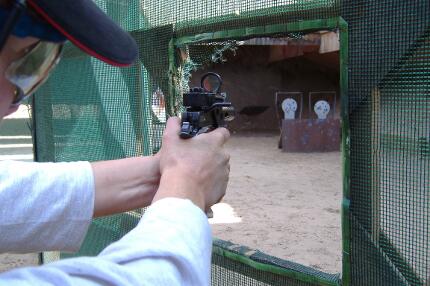
Trigger
The trigger on the Grandmaster is polymer with a flat face, a style popular with a number of top shooters. It is readily interchangeable to suit different styles and hand sizes. Typical trigger pull weight is between three and four pounds. In terms of trigger feel there is a slight initial take up, a clean break and a small amount of over travel to allow the trigger to reset.
The elongated Colt Commander style, wire EDM cut from A-6 tool steel, is lightened to speed up lock time. When coupled with a STI S-7 tool steel sear gives an excellent trigger pull, which on the pistol under test was 3 ½ pounds. The magazine release button is slightly extended ( to aid positive reloads ) but not too much to unintentionally dump the magazine from a holstered pistol. The slide locking lever is recessed into the frame. Several people who handled the gun found it a bit awkward to manually lock open the slide. The easiest way is to pull back the slide using the cocking serrations with your support hand, while twisting the pistol slightly in your strong hand and pushing the slide locking lever up with your strong hand thumb.
The trigger pull is satisfactory by factory standards, but heavy for competition use. Most competition shooters in Open Division like lighter trigger pulls, generally around two pounds. With today’s precision manufacturing techniques and hardened steel materials a two pound trigger pull on a M1911 is easy for an experienced gun smith to set up. STI set the trigger to be controllable by any user; while more experienced shooters can have a gun smith tune it to their requirements.
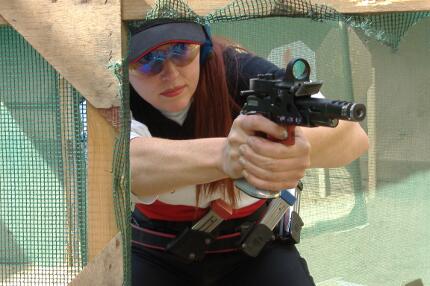
Note the blast guard at the front of the C-More, which deflects the expanding muzzle gases flowing through the compensator. STI European Team member Irene Canetta uses a blued steel GM in .38 Super calibre to compete in IPSC Open Division.
The GM is not fitted with extra firing
pin block, which is used by several manufacturers to fit their current
production 1911 models. This addition can make the trigger pull heavier
and less smooth. The firing pin in the Grand Master has a heavier
spring, which is a solution used in
The magazine release button can be
drilled and tapped to attach wider and bigger buttons. The magazine
release button drops the magazines cleanly when either empty or
partially loaded. The magazine well is fitted to the gun with one pin
that also holds the mainspring housing, so it is easy to remove, when
needed. The fit of this magazine well to the frame is clean, without any
overlap. The magazine well at the base of the grip is flared in order
to accomplish fast reloads.
The magazines for the GM can be up to
170mm in length to be eligible for IPSC Open Division. They can have a
capacity of some 24 rounds of .38 Super calibre rounds. The magazines
can easily be taken apart for occasional cleaning. The GM is built to be
race ready from the box, for IPSC Open Division. The .38 Super is the
cartridge of choice in this division, which size for size, it has a
greater magazine capacity than any other major calibre round.
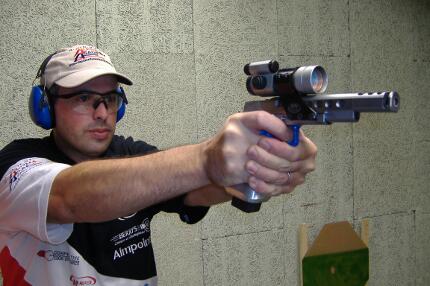
The STI GM is based on the M1911. The barrel is five inches long ( minus the compensator ), which fits directly in the slide, without a barrel bushing. This means the barrel can be of larger diameter and heavier, which also assists in the reduction of muzzle climb. Bucking the C-More trend, Saul Kirsch competes in IPSC Open Division with an Aimpoint sight attached to his GM.
A few years ago the IPSC major power factor (bullet weight in grains, multiplied by the velocity in feet per second and divided by 1,000) was 175. In .38 Super calibre this took a heavy toll on IPSC Open Division pistols and their component parts. The power factor has now been lowered to 160 for IPSC, (USPSA is 165) which means fewer trips to the gunsmith for replacement parts or repairs.
The .38 Super was developed in the 1930’s due to a request from
Colt developed the M1911 in .38 Super calibre, which launched a 130 grain full metal jacket bullet at some 1100 to 1200 feet per second. The narrower diameter bullet at a higher velocity had no problems in penetrating car body work. The .38 Super cartridge lay in the doldrums for many years until it was found to be the ideal calibre for IPSC Open Division, which has given it a major boost in popularity.
Race guns are built to close tolerances and sometimes need a break in period. STI suggest running 500 rounds through the Grand Master to burnish moving parts for smooth operation before taking it to a match. Before taking this or any pistol to a competition, or more seriously, carrying it for your personal defense, you should fire this amount of ammunition through it, utilising all the magazines you have for it.
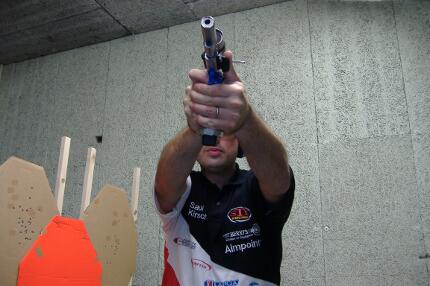
The S-2 compensator fitted to this .38 Super GM allows the expanding gases to flow upwards and outwards, thus reducing the muzzle climb, which allows faster follow up shots.
Range Tests:
Accuracy testing was carried out at 25 yards using a mixture of factory ammunition and ammunition reloaded to IPSC major power factor. With the pistol rested five shot groups of between one and two inches in size were achieved. This is due in no small part to the excellent sights and trigger. Standing with two hands unsupported gave a ten shot group of four inches at 25 yards. I also carried out a series of speed drills in drawing from the holster, shooting with two hands, strong hand and weak hand at one and multiple targets from five to twenty five yards. I fired double taps with both, strong and weak hands as fast as I could obtain a sight picture and also fired deliberately aimed shots at the upper A/B zone of a practical pistol target. The Ghost competition holster was used to hold the Executive during this exercise. The holster is adjustable for both height and angle of carry for a smooth uninhibited draw. Draws from the Ghost were faultless. Single shots, double taps and rapid fire strings all found their mark.
Firearms Development
In the 1980s the founder of STI, Virgil Tripp, was hand crafting competition M1911 pistols using basically the same components and techniques of other gun smiths of that era. Because of the need for product improvement, Tripp Research Inc., ( now STI International ), lead the firearms industry into the precision world of EDM hammers, sears, and other components.
From this highly successful line of precision components, STI then pioneered the modular frame which provided a multitude of desirable features such as a 30 lines per inch ( lpi ) full checked grip assembly, 25 lpi checkered trigger guard, 35% weight reduction, less felt recoil, higher capacity, and repeatable dimensions.
Then STI introduced complete pistols of such quality they quickly became the standard by which other pistols used in IPSC competitions are measured.
Now STI leads the industry again with precision subassemblies in progressive stages of factory completion. Using EDM and CNC machine tools and precision grinding equipment, STI can supply slides and frames on which gun smiths can use to build match pistols for customers.
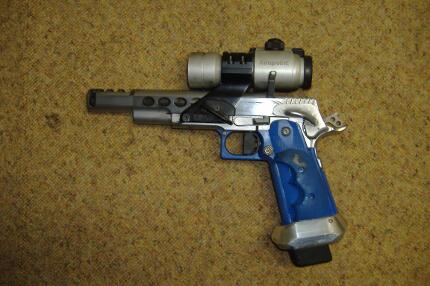
The trigger on the Grandmaster is polymer with a flat face, a style that has been made popular by a number of top shooters. It is readily interchangeable to suit different styles and hand sizes. Note oval lightening holes in the slide.
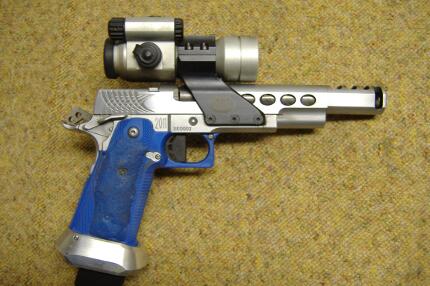
Built on the steel / nylon modular frame, the Grand Master uses STI’s classic slide and with the “saber tooth” rear cocking serrations, which are both visually striking and functionally effective. Note Saul’s personalised serial number.
STI IPSC Team
As well as sponsoring a major match in
Conclusion:
High capacity M 1911 style pistols are not just popular among target shooters. Law enforcement officers and military units who were familiar with the M1911 realised that many of the features that were desirable in a pistol for IPSC competition shooting were equally beneficial in a pistol carried on duty. The US Army's Special Forces Operational Detachment ( Delta Force ), FBI Hostage Rescue Team and LAPD SWAT are among many agencies that carry M1911 cocked and locked .45 caliber pistols. Many of the features that are found on the pistols that these units carry were originally developed for and tested in the field of IPSC competition pistol shooting.
An accurate pistol is only one part of practical pistol shooting. IPSC, SWAT and Hostage Rescue require dynamic shooting. They require that the shooter and weapon act “as one”. The shooter needs to know how to handle his gun and how it will perform in all situations that they will face. That requires a well made weapon that is accurate, dependable and, above all, one that will not have any malfunctions or other problems. Those who demand the ultimate is the reason why STI pistols are so popular among top shooters (and not just target shooters) around the world.
www.stiguns.com